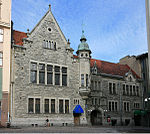Rikhardinkatu library
Buildings and structures in HelsinkiKaartinkaupunkiLibraries in Finland

The Rikhardinkatu library is a public library in Kaartinkaupunki, Helsinki, Finland.
Excerpt from the Wikipedia article Rikhardinkatu library (License: CC BY-SA 3.0, Authors, Images).Rikhardinkatu library
Korkeavuorenkatu, Helsinki Kaartinkaupunki (Southern major district)
Geographical coordinates (GPS) Address Nearby Places Show on map
Geographical coordinates (GPS)
| Latitude | Longitude |
|---|---|
| N 60.166222222222 ° | E 24.946111111111 ° |
Address
Korkeavuorenkatu 43
00130 Helsinki, Kaartinkaupunki (Southern major district)
Finland
Open on Google Maps










